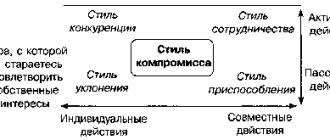A reference group is a social real or imaginary association that is a reference standard in the human mind, a source of development of value orientations and social norms. A reference group is a group that a person recognizes as a means of reference for evaluating himself and those around him. Referent groupings perform various functions. Accordingly, comparative, normative, and ideal groups of presence, fictional and real, positive and negative are distinguished. One group can be perceived by one person in several forms, for example, it can be normative and real at the same time.
The reference group may not at all coincide with the collective in which the individual is present. But, usually a person has several social associations and their number only increases; depending on the content of the problem, the individual turns to all groups whose norms will be mutually reinforced, or intersect, or even contradict (which leads to the formation of intrapersonal conflicts, sometimes to development of mental illness). Even if an individual develops new reference groups, the old ones still retain influence.
What is a reference group?
There are several definitions of this phenomenon. Two definitions are commonly used:
- A reference group is understood as a certain grouping of people capable of somehow influencing the decisions made by an individual. The number of such groups may be more than one, and the individual may not consider himself a member of it. In addition, the reference group can influence other cognitive characteristics of a person.
- Also, a reference group is understood as an association of individuals perceived by another person as a certain ideal that is worth emulating when making decisions.
In our case, both definitions are suitable. Reference groups have an indirect or direct influence on people and in every possible way provoke them to purchase specific goods or use certain services.
At the same time, the phenomenon itself is much broader and affects many aspects of people’s lives. Such groups can influence the way a person thinks, acts, lives, treats other people, etc.
Bibliography.
Psychology and ethics of business communication: a textbook for university students/Ed. V.N. Lavrinenko-5th ed. M: UNITY-DANA, 2006.
Krichevsky R.L., Dubovskaya E.M. Social psychology of a small group. - M.: Aspect-Press, 2001.
Andreeva G. M. Social psychology. M.: Aspect-Press, 1996.
Sventsitsky A.L. Social psychology: Textbook. - M.: TK Velby LLC, 2003.
Aronson E. Social animal. - M.: Aspect-Press, 1998
Pochebut L.G., Chiker V.A. Organizational social psychology. - St. Petersburg: Rech, 2000.
https://de.ifmo.ru/—books/0062/4.html
https://www.portalus.ru
If you are the author of this text and believe that your copyright is being violated or do not want the text to be published on the ForPsy.ru website, send a link to the article and a removal request:
Reference groups in marketing
The group itself may not be a real gathering of people (family, colleagues, interest group, etc.), but a virtual one. The concept of a consumer reference group is gradually blurring. There are too many groups, and most of them exist far from people.
These may simply be rich people whom the individual focuses on. People who own a similar product (you can say hello to those who are still fighting on the Internet about the topic “iOS vs Android”). People who play the same sport or do the same job. There are plenty of examples.
In marketing it works like this:
- The corporation analyzes the target audience.
- She looks at which category she considers herself to be or would like to belong to.
- They build their advertising campaign on the basis of this reference group.
Sometimes companies invite prominent representatives of the association and use their name and image to advertise the product. Sometimes it turns out well and beautifully for everyone, and sometimes it turns out to be an advertisement for Lays chips with Messi.
Types of reference groups
Typically, consumer reference groups are divided into three segments with subgroups based on their global characteristics, sometimes adding some more narrowly focused types of associations to the classifications.
By degree of impact
- Primary groups are the smallest and closest communities to a person: family, colleagues, friends. That is, those with whom a person actually interacts on a regular basis, being part of the group directly, and not just imaginary.
- Secondary groups are larger associations, sometimes exclusively ideological. Interaction between its members may occur infrequently or exclusively remotely. Or it may never happen at all.
According to the characteristics of relationships in the group
- Formal are all communities in which human participation is at least somehow documented. For example, belonging to a political party or working in a company.
- Informal - any group where there are no strict rules. Some kind of club of interests without a specific hierarchy and structure, or a group of friends, hobby partners.
According to the degree of self-acceptance in the group and the characteristics of the team
- Positive - associations with which an individual wants to associate himself and from where he draws inspiration. Communities where people live, from whom he takes an example and who are able to influence his choice.
- Negative - communities where individuals live that a person does not like. He would like to avoid interaction with them, as well as any association with this group.
Also, groups such as value groups are sometimes included in the classification - associations based on common views of the world. Informational, where experts usually live, sharing opinions with each other and group members, or utilitarian, i.e. associations, participation in which gives a person some benefits.
Principle of reference
Of unique importance to the study of personality is the study not only of individual characteristics, but also of intergroup tendencies and relationships that contribute to the development of human reactions and views. The definition of reference is used in the construction of experimental psychodiagnostic studies, which are based on certain principles
This is the principle of adequacy (correspondence of the research method to the phenomenon being studied), parallelism (registration of indicators parallel to the process being studied), extremeness (creation of such a critical situation when the studied properties are most clearly manifested), gradient registration (registration of parameters in diverse situations), consistent explanation (use for explanations of only the two closest levels of generalization), psychological expediency (not all processes are of a psychological nature) and the principle of reference
The definition of reference is used in the construction of experimental psychodiagnostic studies, which are based on certain principles. This is the principle of adequacy (correspondence of the research method to the phenomenon being studied), parallelism (registration of indicators parallel to the process being studied), extremeness (creation of such a critical situation when the studied properties are most clearly manifested), gradient registration (registration of parameters in diverse situations), consistent explanation (use for explanations of only the two closest levels of generalization), psychological expediency (not all processes are of a psychological nature) and the principle of reference.
The principle of reference is used to simplify and rationalize the research process in situations where the entire system under study is displayed in a single location, as if in focus. In this case, there is no need to carry out a huge number of registration data, which speeds up the research process and increases its accuracy and efficiency. This principle applies to other scientific fields where similar mapping laws apply.
When studying a person’s attitude to various groups of people, it is possible to draw up his personal portrait, identify his motivational orientation, and professional orientation. The study of the system of these relationships is not only a multifaceted method of psychodiagnostics, but also a method of formation and development of personality, its leading orientations, and motives.
The principle of reference in matters of pedagogical activity is important. Identifying the child’s standard groupings, significant ideas and people helps to form the necessary personality qualities. With the correct use of this data and through the use of the principle of reference, it is possible to push a person to certain judgments and actions. What nature or direction they will be depends on the significant grouping, since the child will not particularly critically perceive the information provided by the reference group or its representative.
Forms of influence on consumers
4 main forms of influence:
- Reward.
- Compulsion.
- Legitimate power.
- The power of self-identification.
We are most interested in the power of reward and self-identity.
In the first case, we are talking about rewards for following the rules and belonging to the group. This can be either an incentive at work for strictly following the rules of the team, or a discount for using the services of a specific company. Referral programs and savings systems work in a similar way. Companies seem to be telling customers and users: “If you play by our rules, we’ll give you bonuses.”
Self-identification is a little more complicated. Here, the brand needs to present its product in such a way that the user considers the use of this product beneficial. No discounts. All kinds of luxury brands work on this principle: owning a certain product makes the consumer “special”, and he happily buys into it.
Coercion and legitimate power operate in the context of political organizations and labor relations.
Other forms of consumer interaction with reference groups and brands
Value form of influence
Sometimes companies use a not entirely fair game, trying to play on certain feelings of the audience, forming groups of loyal consumers and using a value-based form of influence. A brand can declare that it supports the LGBT community and promote its products among this category of users. The company associates itself with this group of people and attracts their attention because support is important to this association.
You can also put pressure on other problems, for example, with the environment or poaching, by offering products that do not harm nature. Or by offering products for children, supposedly defending family values. In general, people's ideological views are taken under control.
Information form of influence
Sometimes the popularity of a brand is influenced by users. This can be either a large group of people or a small association without big names. For example, if a person wears a particular clothing brand and praises its quality, then those who respect his opinion will also be predisposed to buy items from that brand.
In such groups, either experienced users or people with authority play a key role.
Why do reference groups exist?
Marketers are studying this phenomenon to increase sales and better control consumers. It’s much easier to sell a product, service, service, or force someone to perform some action if you can find something in common in the audience of interest and hit it specifically.
For this reason, brands use celebrities in advertising and hire ambassadors, i.e. people who use their popularity to promote a brand. Usually this promotion consists only of public use of the product.
Reference groups always influence our actions, the choice of goods, food, organizations, etc. Therefore, Apple reluctantly shares functions and programs with other operating systems. She knows that if someone in the family uses an iPhone, this someone, for the sake of his own convenience, will convince the whole family to buy iPhones. And then it won’t be possible to jump off, because the family is a very effective reference group. And there are many such examples.
Our desire to associate ourselves with someone and focus on someone always plays into the hands of marketers.
Self-reference (self-reference)
Self-reference occurs in natural or formal languages when a sentence, idea, or formula refers to itself. The reference can be expressed either directly (through some intermediate clause or formula) or through some encoding. In philosophy, it also refers to the ability of a subject to talk about or refer to himself: to have a type of thought expressed in the nominative singular case of the first person.
Self-reference has been studied and has applications in mathematics, philosophy, computer programming, and linguistics. Self-referential statements are sometimes counterintuitive and can also be considered recursive.
In classical philosophy, paradoxes were created by self-referential concepts, such as the paradox of omnipotence: to establish whether it was possible for a being so powerful that it could create a stone that it could not lift. Epimenides' paradox "All Cretans are liars", uttered by an ancient Greek Cretan, was one of the first recorded versions. Modern philosophy sometimes uses the same technique to demonstrate that an intended concept is meaningless or ill-defined.
Shaping fashion
One of the most powerful mechanisms of influence on buyers, which is generated by reference groups, is fashion.
Fashion is a value in which the norm of external behavior of others is perceived by the individual as his own need and desire (to have something, to be someone).
Fashion is an extremely sudden phenomenon that quickly forms and quickly fades away. Some artist puts on new sneakers, and they immediately become part of fashion, which means everyone wants them. And when friends, acquaintances and just fellow countrymen around you start wearing these sneakers, you involuntarily begin to look at them.
Brands themselves shape fashion, attacking large reference groups, and thereby attract a more mass audience to their camp.
Psychology
In psychology, reference is a very common concept found in several theories.
From a mental processing perspective, psychology uses self-reference to establish identification with a mental state during introspection. This allows a person to develop his own guidelines to a greater degree of immediate awareness. However, it can also lead to circular reasoning, preventing thinking from developing. According to Perceptual Control Theory (PCT), the reference condition is the state in which the output of the control system tends to change the controlled quantity. The basic statement is that “all behavior is oriented at all times to the control of certain quantities in relation to specific reference conditions.”










